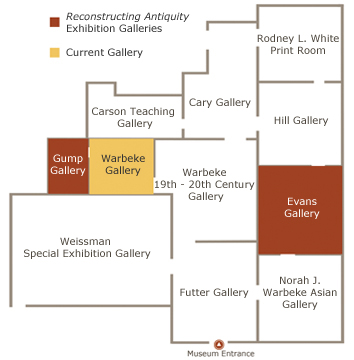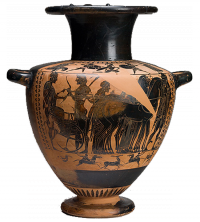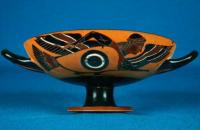Athena stepping into a chariot as Herakles, Apollo, a female goddess (head now missing), and Hermes look on
Learn more about the object below
In ancient Greece water was collected and stored in clay jars known as hydrias, a shape distinguished by an unusual arrangement of handles—two horizontal handles at the sides for lifting and one vertical handle for pouring. Archaeological and literary evidence indicates that the water supply of Athens was greatly improved by construction of an aqueduct and new fountain houses at the end of the sixth century BCE. Several hydrias from this time depict women congregating at fountains to retrieve their household’s supply of water. Perhaps such scenes celebrated this important civic advance, a dramatic convenience compared to old-fashioned wells.
Athenian black-figure vase-painters were fond of depicting their city’s patron goddess, Athena, who is shown mounting her four-horse chariot on this vase from Mount Holyoke's collection. Other deities are nearby; the sun-god Apollo plays his lyre, and the messenger Hermes leads the way wearing winged boots. Greek art illustrates gods in procession when they were on their way to a council meeting or to the wedding of Peleus and Thetis. The presence of Herakles with his club and bow suggests, however, that this scene depicts the hero’s journey to Mount Olympus, where he will join the gods in their lofty palace.
In addition to the main scene on this hydria, there are two other zones with figural work: the shoulder and the frieze below the panel, sometimes called a predella. The shoulder zones of hydrias were often decorated with generic subjects, usually unrelated to the primary scene. Here are three warriors flanked by watching women. On rare occasions, a specific myth is shown, perhaps one of Herakles’ labors or an episode from the history of the Trojan War. On most hydrias the predella is filled only with a vegetal pattern of palmettes. A few painters preferred a row of wild animals, here enlivened by the addition of hunters on horseback.
In 1973 archaeologist Diana Buitron-Oliver attributed this hydria to the hand of the so-called Eye-Siren Painter. Most Greek vases do not have artist signatures, but stylistic idiosyncrasies allow experts to determine which may have been painted by the same person. The Eye-Siren Painter is named after an amphora in the British Museum (B215) that features two sirens (birds with human heads) with eyes for bodies, a curiosity first seen in the work of the Amasis Painter, a major black-figure artist. Dr. Buitron-Oliver believed similarities between the Mount Holyoke hydria and the London amphora were close enough to allow identification of the painter.
Label texts by Pamela J. Russell, Ph. D., Andrew W. Mellon Coordinator of College Programs, Mead Art Museum, Amherst College.
Suggested readings:
John Boardman, Athenian Black Figure Vases: A Handbook. London: Thames and Hudson, 1974.
John M. Camp, The Archaeology of Athens. New Haven: Yale University Press, 2001.
Thomas H. Carpenter, Art and Myth in Ancient Greece: A Handbook. New Haven: Thames and Hudson, 1991.






